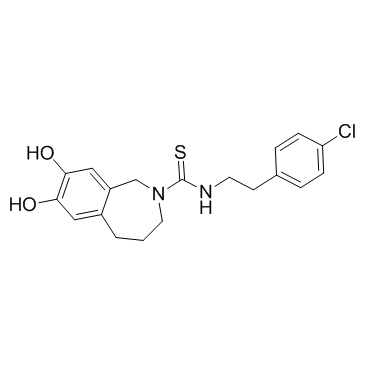Capsazepine

Capsazepine structure
|
Common Name | Capsazepine | ||
|---|---|---|---|---|
| CAS Number | 138977-28-3 | Molecular Weight | 376.900 | |
| Density | 1.4±0.1 g/cm3 | Boiling Point | 581.1±60.0 °C at 760 mmHg | |
| Molecular Formula | C19H21ClN2O2S | Melting Point | 155-157°C | |
| MSDS | Chinese USA | Flash Point | 305.3±32.9 °C | |
Use of CapsazepineCapsazepine is a synthetic analogue of the sensory neurone excitotoxin, and an antagonist of TRPV1 receptor with an IC50 of 562 nM. |
| Name | capsazepine |
|---|---|
| Synonym | More Synonyms |
| Description | Capsazepine is a synthetic analogue of the sensory neurone excitotoxin, and an antagonist of TRPV1 receptor with an IC50 of 562 nM. |
|---|---|
| Related Catalog | |
| Target |
TRPV1 receptor[1] |
| In Vitro | Capsazepine (50 μM) optimally enhances the upregulation of (death receptors) DRs without affecting cell viability HCT116 cells. Capsazepine (30-50 μM) induces ROS generation and ROS mediate Capsazepine-induced DR5 upregulation in HCT116 cells[1]. Capsazepine (1-100 μM, 45 min preincubation) inhibits the evoked CGRP-LI release. Capsazepine (3-100 μM) prevents low pH- and capsaicin-induced CGRP-LI release from rat soleus muscle at concentrations which do not affect the release evoked by KCl. Capsazepine (3-100 μM, without 10 μM) produces a nonspecific inhibitory effect on CGRP-LI release from peripheral endings of the capsaicin-sensitive primary afferent neurone[2]. |
| In Vivo | Capsazepine (15 mg/kg, s.c.) prevents the increase in respiratory system resistance and decreases the increase in tissue damping during endotoxemia. Capsazepine attenuates lung injury evidenced by reduction on collapsed area of the lung parenchyma induced by LPS[3]. |
| Cell Assay | To assay intracellular ROS, HCT116 cells are preincubated with 20 μM dichlorofluorescein diacetate (DCF DA) for 15 min at 37°C and then treated with Capsazepine. After 1 h of incubation, the increase in fluorescence resulting from the oxidation of DCF DA to DCF is measured by flow cytometry. The mean fluorescence intensity at 530 nm is calculated for at least 10,000 cells at a flow rate of 250-300 cells/s. |
| Animal Admin | To verify the role of TRPV1 on lung mechanics during LPS-induced ALI, the animals (n = 10 per group) are pre-treated with vehicle or Capsazepine (15 mg/kg; s.c.), then receive saline or LPS (5 mg/kg, i.p.) after 10 min. Thus, the mice are randomly divided into four groups with 10 mice in each group: (i) control (vehicle + saline), (ii) Capsazepine + saline, (iii) vehicle + LPS and (iv) Capsazepine + LPS. After a 24-hr treatment with saline or LPS, the mice are anaesthetized and paralysed with pancuronium bromide and lung mechanics function is evaluated. Afterwards, the lungs are removed for histology. |
| References |
| Density | 1.4±0.1 g/cm3 |
|---|---|
| Boiling Point | 581.1±60.0 °C at 760 mmHg |
| Melting Point | 155-157°C |
| Molecular Formula | C19H21ClN2O2S |
| Molecular Weight | 376.900 |
| Flash Point | 305.3±32.9 °C |
| Exact Mass | 376.101227 |
| PSA | 87.82000 |
| LogP | 3.50 |
| Vapour Pressure | 0.0±1.7 mmHg at 25°C |
| Index of Refraction | 1.672 |
| InChIKey | DRCMAZOSEIMCHM-UHFFFAOYSA-N |
| SMILES | Oc1cc2c(cc1O)CN(C(=S)NCCc1ccc(Cl)cc1)CCC2 |
| Storage condition | 2-8°C |
| Water Solubility | methanol: soluble |
| Personal Protective Equipment | Eyeshields;Gloves;type N95 (US);type P1 (EN143) respirator filter |
|---|---|
| Hazard Codes | Xn |
| Risk Phrases | R20/21/22 |
| Safety Phrases | S22-S24/25 |
| RIDADR | 2811 |
| WGK Germany | 3 |
| Packaging Group | II |
| Hazard Class | 6.1(a) |
|
Cross-talk between alpha1D-adrenoceptors and transient receptor potential vanilloid type 1 triggers prostate cancer cell proliferation.
BMC Cancer 14 , 921, (2014) There is evidence that calcium (Ca(2+)) increases the proliferation of human advanced prostate cancer (PCa) cells but the ion channels involved are not fully understood. Here, we investigated the corr... |
|
|
Cannabinoids increase lung cancer cell lysis by lymphokine-activated killer cells via upregulation of ICAM-1.
Biochem. Pharmacol. 92(2) , 312-25, (2014) Cannabinoids have been shown to promote the expression of the intercellular adhesion molecule 1 (ICAM-1) on lung cancer cells as part of their anti-invasive and antimetastatic action. Using lung cance... |
|
|
Piperine inhibits the growth and motility of triple-negative breast cancer cells.
Cancer Lett. 357(1) , 129-40, (2014) Piperine, an alkaloid from black pepper, is reported to have anticancer activities. In this study, we investigated the effect of piperine on the growth and motility of triple-negative breast cancer (T... |
| N-[2-(4-Chlorophenyl)ethyl]-1,3,4,5-tetrahydro-7,8-dihydroxy-2H-2-benzazepine-2-carbothioamide |
| MFCD00153778 |
| 2H-2-Benzazepine-2-carbothioamide, N-[2-(4-chlorophenyl)ethyl]-1,3,4,5-tetrahydro-7,8-dihydroxy- |
| N-[2-(4-chlorophenyl)ethyl]-7,8-dihydroxy-1,3,4,5-tetrahydro-2-benzazepine-2-carbothioamide |
| Capsazepine |
| N-[2-(4-Chlorophenyl)ethyl]-7,8-dihydroxy-1,3,4,5-tetrahydro-2H-2-benzazepine-2-carbothioamide |